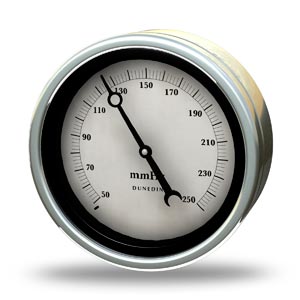Hypertension is associated with an increased risk of stroke, myocardial infarction, heart failure, end-stage renal disease
and premature death.1 However, most people who are at high risk of cardiovascular events have multiple modifiable
risk factors, such as a sedentary lifestyle, suboptimal nutrition, smoking and elevated blood lipids or blood glucose.1 Management
of blood pressure should therefore be viewed as one of a number of tools that can be used to reduce a patient’s total
cardiovascular risk.
The New Zealand cardiovascular guidelines provide the following “rules of thumb” for managing cardiovascular risk:2
- Every patient can benefit from a healthier lifestyle, e.g. increased exercise, reduced salt and alcohol intake, increased
consumption of fresh fruit and vegetables
- Most patients with a five-year cardiovascular risk less than 10% do not need cardiovascular medicines
- Antihypertensive and/or lipid-lowering medicines may be appropriate for patients with a five-year cardiovascular risk
of 10–20%, and the benefits and risks associated with this approach discussed
- Patients with a five-year cardiovascular risk of 20% or more are likely to gain significant benefit from antihypertensive,
lipid-lowering and antiplatelet medicines
This wider view of the patient’s total cardiovascular risk encourages clinicians to consider blood pressure in the context
of all other risk factors. Determining an appropriate blood pressure treatment goal is therefore not straightforward.
The issue is further complicated with evidence now emerging in support of intensive blood pressure management, i.e. a
systolic blood pressure target less than 120 mmHg.
So, the question is: how low should blood pressure go to reduce cardiovascular risk while minimising adverse effects?

The first trial to investigate the effects of intensive blood pressure management on cardiovascular outcomes was the
Action to Control Cardiovascular Risk in Diabetes (ACCORD) in 2010. The results of ACCORD provided evidence that intensive
blood pressure management was unlikely to benefit large groups of patients.
ACCORD was effectively three clinical trials designed to investigate whether intensive lowering of blood pressure, blood
glucose or blood lipids reduced the risk of cardiovascular events in patients with type 2 diabetes. In total 10,251 participants
were enrolled, and in the blood pressure arm approximately 4733 people with type 2 diabetes were assigned to one of two
systolic treatment targets; less than 120 mmHg (intensive treatment) or less than 140 mmHg (standard treatment).3
After one year, the mean systolic blood pressure for patients in the intensive treatment group was 119 mmHg compared
to 134 mmHg in the standard treatment group.3 Patients were followed for an average of 4.7 years.3 The
investigators found that a systolic blood pressure target of less than 120 mmHg did not result in a reduced rate of composite
cardiovascular outcomes, i.e. myocardial infarction, other acute coronary syndromes, stroke, heart failure, or death from
cardiovascular causes, or a reduction in death from any cause.3 However, there was a significant reduction
in both total strokes and non-fatal strokes for patients in the intensive treatment group.3 ACCORD found that
serious adverse events such as hypotension, bradycardia or arrhythmia, and elevations in serum creatinine were more common
in patients managed intensively than patients receiving standard care.3
SPRINT provides evidence in support of intensive management
The situation changed in 2015 with the publication of the Systolic Blood Pressure Intervention Trial (SPRINT). This
study provided evidence in support of intensive blood pressure management to a level well below 140 mmHg for adults with
elevated cardiovascular risk without diabetes.
SPRINT assigned 9361 people aged over 50 years with a systolic blood pressure of 130 –180 mmHg to either intensive treatment
(< 120 mmHg) or standard treatment (< 140 mmHg).4 SPRINT was designed to recruit subjects with an average
annual cardiovascular risk of approximately 2%, i.e. the equivalent of a five-year cardiovascular risk of 10%.5 Patients
were able to be prescribed any antihypertensive medicine during the trial period.4 A major strength of the
trial was the large sample size, and an additional advantage was that it included older people: 28% of participants were
aged over 75 years, 33% of whom were classified as “frail”.4, 6 It should be noted, however, that SPRINT used
a method for measuring blood pressure that is likely to have resulted in lower values compared to blood pressure measured
in clinical practice or other trials (see: “The limitations of SPRINT”).
After one year, the mean systolic blood pressure for patients in the intensive treatment group was 121 mmHg compared
to 136 mmHg in the standard treatment group.4 SPRINT reached an early finish line in its fourth year when it
became clear that patients receiving intensive treatment were benefiting more than patients receiving standard care. There
was a statistically significant lower composite annual rate of myocardial infarction, acute coronary syndromes, heart
failure or death from cardiovascular causes of 1.65% in the intensive treatment group compared with 2.19% for patients
receiving standard care.4
During the study period 155 patients (3.3%) in the intensive management group died, compared to 210 (4.5%) of those
who received standard care.4 Adverse effects causing serious harm, i.e. hypotension, syncope, electrolyte abnormalities
and acute kidney injury/failure (but not injurious falls) were, however, more common in the intensive treatment group
(4.7%) compared to the standard treatment group (2.5%).4
For further discussion of adverse effects, see: “As management intensifies
adverse effects increase”.
Benefits were similar regardless of age
Subsequent subgroup analyses of patients in SPRINT aged over 75 years (living in the community) confirmed that the benefits
of intensive blood pressure management compared to standard care were maintained.6, 7 The type and frequency
of adverse effects in patients aged over 75 years was similar to those reported for the whole study population.4 There
was also no significant difference in the rate of injurious falls between the patients receiving standard or intensive
care in the over 75 year age group.6 This suggests that age alone is not a reason to avoid intensive blood
pressure management in older patients who are active and otherwise healthy.
The limitations of SPRINT
The SPRINT authors identified a number of limitations in their study design which might reduce the ability of the results
to be generalised.4 Several groups were excluded from SPRINT, such as patients with diabetes, a history of
stroke or aged under 50 years.4 SPRINT also did not enrol people with low cardiovascular risk or people living
in residential care facilities.4 It has also been noted that SPRINT had a relatively high rate of drop-out
with over 10% of patients either discontinuing treatment, withdrawing consent or being lost to follow-up; this compares
to less than 5% in ACCORD.3, 4
Another potential limitation of SPRINT is that even though the blood pressure measurements recorded in the trial may
more accurately reflect true blood pressure, they may not be comparable to measurements taken in other trials or in clinical
practice. SPRINT participants had their blood pressure measured using an automatic device while alone in the room and
this technique will often produce systolic blood pressure measurements that are substantially lower, e.g. 5–15 mmHg, than
those obtained in routine practice when a clinician is present. This casts uncertainty over whether the beneficial effects
seen in SPRINT in patients with a systolic blood pressure under 120 mmHg, were actually more likely to be associated with
a slightly higher blood pressure, as measured by a clinician.
Since publication a number of clinicians have therefore cautioned against using the results of SPRINT to surmise that
large portions of the population would benefit from intensive management of blood pressure.8 This caution is
supported by the results of the Heart Outcomes Prevention Evaluation (HOPE)-3 trial, which showed that patients with a
lower cardiovascular risk, i.e. a five-year cardiovascular risk of 5%, are unlikely to benefit from intensive management
of blood pressure.9
Can the differences between the SPRINT and ACCORD be explained?

The SPRINT and ACCORD studies provide contrasting evidence of the benefit of intensive management of blood pressure.
However, there are key differences between the two studies which may explain the contradictory results, including that:
- SPRINT excluded people with diabetes whereas ACCORD exclusively enrolled people with type 2 diabetes
- SPRINT included some patients with CKD while CKD was an exclusion criterion in ACCORD.
- Patients in ACCORD were younger with a mean age of 62 years, compared to 68 years in SPRINT, meaning they may have
had less subclinical cardiovascular disease and therefore less benefit to be gained from intensive management of blood
pressure
- As previously mentioned, the two studies used different blood pressure measurement methodologies casting doubt over
whether the results can be compared
- The incidence of cardiovascular events in ACCORD was lower than expected meaning the study was under-powered and therefore
had reduced sensitivity to detect differences in cardiovascular outcomes
- SPRINT was stopped early due to the significantly reduced rate of cardiovascular events in the intensive treatment
arm and this may have exaggerated the results
Several years after the results of ACCORD were published a secondary re-analysis was performed that combined all three
arms of the trial (blood pressure, glucose and lipids). It was found that patients who received intensive blood pressure
control and either intensive or standard glycaemic control, had significantly less risk of cardiovascular events than
patients who received standard blood pressure control and standard glycaemic control.10 In other words, adding
the variable of glycaemic control to the statistical analysis resulted in intensive blood control now having a significant
benefit in terms of cardiovascular outcomes. However, these results should be viewed with caution as they are secondary
analyses and the original study was not designed to analyse the variables in this way. Even so, experts are now suggesting
that there are more similarities than differences between SPRINT and ACCORD and their respective results may not be as
incompatible as what was once thought.11
Primary care is of course not about composite outcomes, it is about helping people achieve better health and quality
of life. Reducing a patient’s cardiovascular risk is a cornerstone of this goal. Blood pressure management is an important
component of cardiovascular risk reduction and the cardiovascular benefits of lowering blood pressure in patients with
elevated levels, including in older healthy people, are widely recognised.1, 12 The issue is how low to go
before the adverse effects outweigh the benefits of treatment, and how do the results of clinical trials help you formulate
a treatment strategy for the patient sitting in front of you?
Treatment “targets” should not override clinical judgement
Treatment targets are necessary in clinical trials, but not all of the patients who enrol in these trials reach the
target due to multiple reasons, e.g. non-adherence, adverse effects, treatment resistance. The majority of patients in
the intensive treatment arm of SPRINT did not consistently achieve a systolic blood pressure below 120 mmHg, yet they
still benefitted in terms of cardiovascular outcomes.5
As management intensifies adverse effects increase
Intensive management of blood pressure results in an increased risk of adverse effects, compared to standard care. Some
adverse effects in SPRINT occurred at significantly higher rates in the intensive management group, including:
- Hypotension 2.4% compared to 1.4%
- Syncope 2.3% compared to 1.7%
- Electrolyte abnormalities 3.1% compared to 2.3%
- Acute kidney injury or acute renal failure 4.1% compared to 2.5%
Although SPRINT did not report increased rates of these adverse effects in patients aged over 75 years it seems likely
that the impact of serious adverse effects could be more deleterious than in younger patients and suggests that a cautious
approach should be taken to intensive blood pressure management in older patients.
Intensive management of any risk factor will also inevitably increase polypharmacy; the mean number of antihypertensive
medicines taken by patients in the intensive group of SPRINT was 2.8. compared to 1.8 in standard care.5 Furthermore,
patients in the intensive group of SPRINT required substantially more consultations to achieve the treatment goal than
those in the standard care group.5
Explaining risk by numbers
SPRINT and other trials provide values that can be used to quantify benefit and risk for patients, this discussion,
however, also depends on how the numbers are presented and how the patient views these risks and benefits for them as
an individual.8 For example, data from the SPRINT trial has been used to estimate the additional benefit and
harm of intensive blood pressure management compared to standard care. If 1000 people underwent intensive blood pressure
management for 3.2 years and were compared to a 1000 people treated to a systolic target of less than 140 mmHg, on average
16 fewer people would experience a cardiovascular event, but 22 more people would experience a serious adverse effect,
such as significant hypotension, syncope, electrolyte abnormalities, acute kidney injury or renal failure.8 Therefore,
on the basis of these numbers alone, the harms of intensive blood pressure control outweigh the benefits. On the other
hand, many of these adverse effects may be manageable and less serious in the longer term than the cardiovascular events
that are being prevented, such as stroke. Numbers can be made to sound more or less impressive depending how they are
expressed.8 SPRINT reported a 25% reduction in the risk of a primary outcome* which might be easily
“sold” to patients.4, 8 However, if expressed as an absolute risk reduction of 1.6% or a decrease in event
rates from 6.8% to 5.2% over 3.2 years, the numbers may make patients more wary, particularly if they are then made aware
that intensive management can be associated with an increased risk of serious harm.8
* First occurrence of myocardial infarction, acute coronary syndrome stroke, heart failure or death from
cardiovascular causes
A suggested approach: assess CVD risk and treat individually
SPRINT and ACCORD are two pieces in a cardiovascular jigsaw puzzle. Undoubtedly, future studies will add to our understanding
and clinical practice will continue to adapt in response. There are, however, two points that do appear to hold true across
the various trials and are likely to do so into the future:
- The higher the patient’s cardiovascular risk, the greater the benefit a reduction in blood pressure will provide
- One target is unlikely to suit all patients
An assessment of cardiovascular risk is therefore important as it can be used to inform the patient of the likely benefit
they will gain from any reduction in blood pressure. Consideration should be given to the patient’s other cardiovascular
risk factors, family history, co-morbidities, concurrent medicines and overall health with the relative importance of
each determined by the patient’s preference and the clinician’s expertise. Keep in mind that any lowering of blood pressure
will lower cardiovascular risk. The “prescription” for how a patient achieves this reduction and how intensely they should
work towards it, is determined on an individual basis.
It is interesting to note that at least one international guideline group has revised their hypertension guideline to
include intensive blood pressure control in selected patients, based largely on the results of SPRINT.13 However,
they also state that they anticipate that intensive control will result in patients having more consultations, more medicines
and more monitoring.
So, do the results of SPRINT change the way we manage blood pressure in New Zealand? Perhaps, but certainly not for
every patient.
Let us know your thoughts on intensive vs. standard blood pressure management. Has SPRINT changed the way
you manage patients with hypertension? Can the results can be extrapolated to the wider general practice population given
the exclusions of the trial and the increased risk of serious adverse effects with intensive blood pressure treatment?
Further information on the intensive management of blood pressure control in older patients is available
in a podcast from the Goodfellow unit:
www.goodfellowunit.org/podcast/intensive-blood-pressure-control-elderly-bruce-arroll
Further information on the management of hypertension is available from: “Hypertension in adults: The silent killer”. Available from:
bpac.org.nz/BPJ/2013/August/hypertension.aspx


